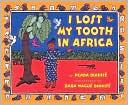by Penda Diakite
Illustrated by Baba Wague Diakite
- publisher and date: Scholastic Press, 2006
- genre: it is listed as fiction in the library but it is based on a true event
- age/grade:ages 4-8
Synopsis (from www.bn.com)
More than anything, Amina wants to lose her loose tooth while visiting her family in Mali, West Africa. Only then can she put it under a gourd for the African tooth fairy, who will exchange it for two chickens! Happily this happens, and even better, the chickens lay eggs. But will the eggs hatch before it’s time to return home to America? In this fresh, spontaneous story that is infused with close family warmth, Penda June Diakite joins forces with her award-winning author/artist father to give a charming peek at everyday life in Mali.
Author’s Perspective: Penda Diakite grew up in Portland,Oregon but travels every year to Mali, Africa to visit her African family. Her father (and the illustrator) was born and raised in Mali. This story was based on a true event that happened on a visit to Mali.
Literary Elements:
Character – The main character is Amina, the author’s sister, speaks to us in the first person. The story takes place in a land most young readers will be unfamiliar with, but they can relate to the loving, extended family and the excitement of loosing a tooth!
Plot – Loosing a tooth is always a big deal to first graders! The plot of this story is something that they can relate to but also introduces young readers to a different culture and a different tooth fairy.
Theme – Family, comparison and merging of cultures, loosing a tooth!
Illustrations – “Vibrant ceramic-tile illustrations by the author’s father, Coretta Scott King Honor Book artist Baba Wague Diakite, are infused with the rich culture of his native Mali.” (from the book jacket)
Curriculum Connections:
- Ideas for parents and teachers from Reading Rainbow
- I Lost My Tooth in _________ – Have students write their own stories of loosing their teeth.
Web Resources:
- Biography of Baba Wague Diakite
- Artwork of Baba Wague Diakite
- Bookfocus – I Lost My Tooth in Africa
- Mali Tourism Information
Reviews:
Publishers Weekly (from www.bn.com)
The creator of The Magic Gourd teams up with his teenage daughter for this story, based on the time the author’s younger sister, Amina, actually did lose a tooth in Mali, while visiting their father’s family. “My dad says if you lose a tooth in Africa and put it under a gourd, you will get a chicken from the African Tooth Fairy!… So I try tricks with my tongue to help it come out faster,” writes Diakit , narrating as her sister, Amina. As the heroine waits for the tooth to come out, she also describes a fascinating daily rhythm within her paternal grandmother’s African home, depicted as a walled compound. “Aunt Kadja has made my favorite dinner. It’s rice and onion sauce with African eggplant and tiny noodles. We all eat together around one big bowl. Everyone eats with their right hand.” After dinner, neighbors come by to play games and tell stories. With often whimsical touches, Baba Wagu Diakit illustrates a vibrant life among banana palms, birds and brightly dressed relatives and friends. Patterned borders surround each illustration, created on a ceramic tile (e.g., feathers and eggs decorate the scene of Amina’s new hen laying eggs; even loose teeth come into play). Young readers may well be intrigued by how universal a milestone it is to lose a tooth, while learning the unique lifestyle of this warm and welcoming West African family. Ages 4-8. (Jan.) Copyright 2006 Reed Business Information.
School Library Journal (from www.bn.com)
K-Gr 4-This story recounts a child’s visit to Mali, where she loses her tooth. After she hides it under a calabash, she waits for the African Tooth Fairy to replace it with a chicken. When her patience runs out and she returns to the gourd to retrieve her tooth, a chicken and a rooster emerge. She is delighted. The strength and enduring warmth of her African extended family emerge fully through thoughtful detail. Grandma N’na gives her a blessing each morning: “May you rise high with strength and knowledge.” When the child returns home to Oregon, Uncle Madou volunteers to take care of the chickens until her return. The vivid ceramic-tile illustrations expand the text, revealing a range of animals, houses, and greenery. At the end are the words to Grandma’s “Good Night Song,” the recipe for African Onion Sauce, and a glossary of Bambara words, all of which add to the authentic feel of the story. In his illustrator’s note, Baba Diakit states, “Storytelling is a gift to me from my elders and I simply wanted to pass this gift along to my children.” He has succeeded, as his artistry supports his daughter’s storytelling beautifully.-Alexa L. Sandman, Kent State University, OH Copyright 2005 Reed Business Information.
